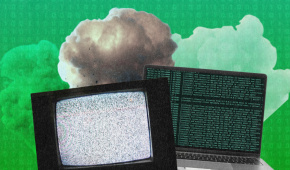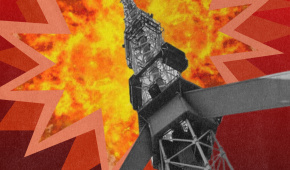Regional journalists’ needs 2024: IMI study
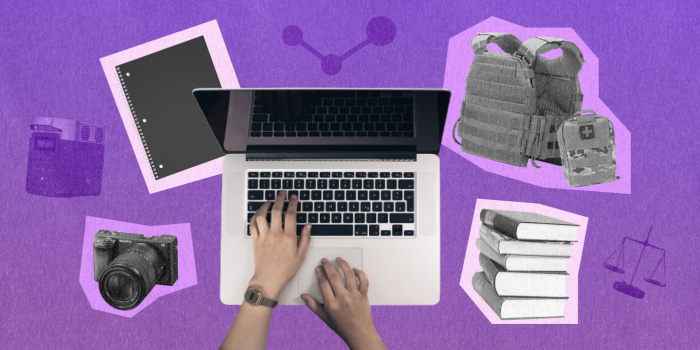
The Institute of Mass Information surveyed* Ukrainian media outlets in 20 oblasts to assess their key needs in the third year of the full-scale invasion.
The survey sample included outlets that had to relocate from the temporarily occupied territories. Overall, the responses could be broadly divided into three categories:
- the occupied and front line regions;
- the oblasts under constant shelling;
- and the regions less vulnerable to direct strikes.
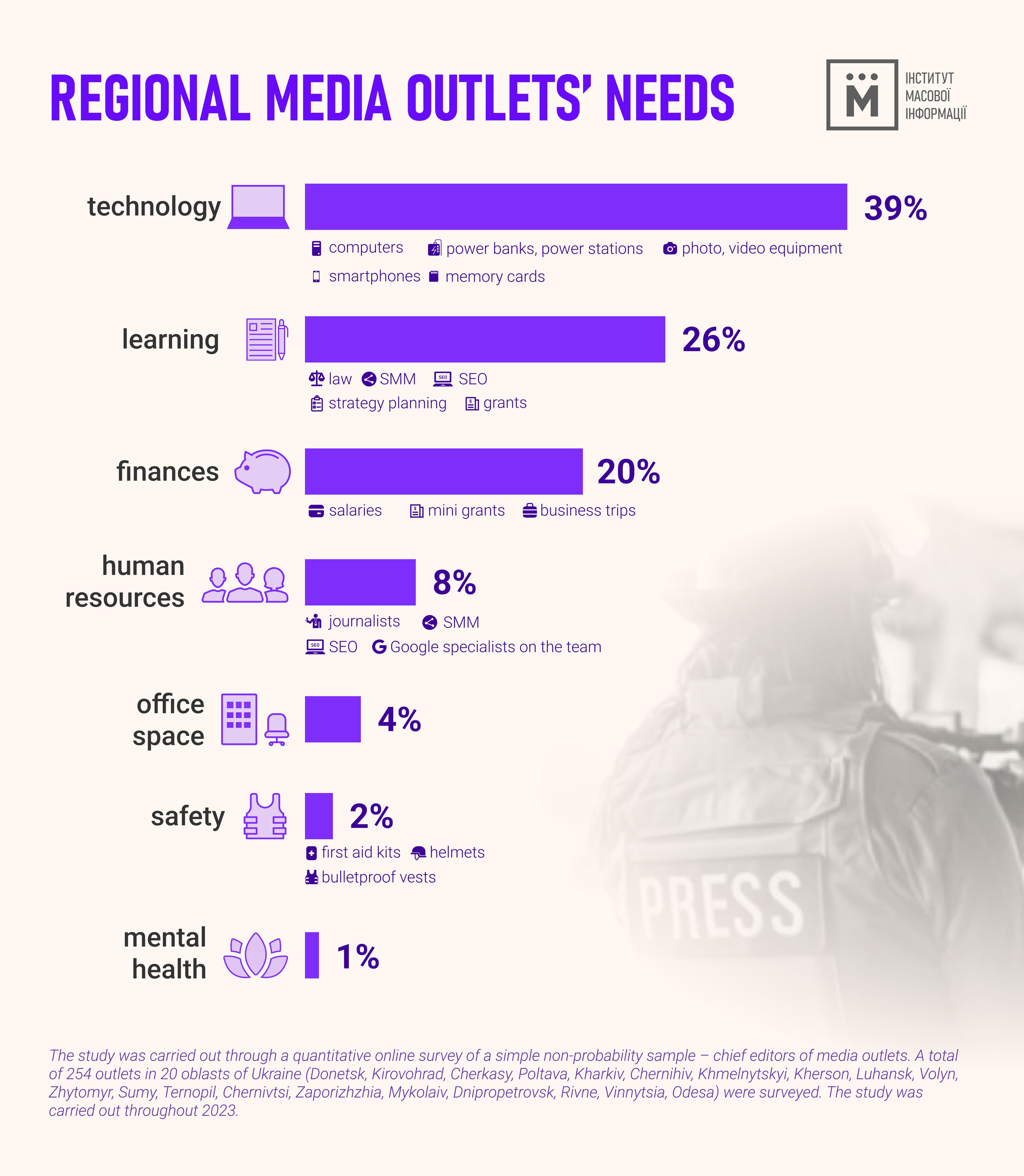
A significant share of the surveyed outlets (39%) said they needed technological equipment to sustain their work (from power generators, power banks and Ecoflow stations to professional photo, video and audio recording equipment). Moreover, the journalists said they needed such technology as power storage devices, hard drives, memory cards, camera lenses, lighting equipment or tripods. The demand highlights the poor financial situation that Ukrainian regional outlets are facing, as they feel the need for technological equipment but are unable to meet it themselves.
A quarter of respondents (26%) mentioned their need for capability building through additional training programs. The journalists expressed a desire to expand their knowledge of legal issues, website traffic optimisation and social media engagement. Much fewer outlets said they wanted to hold a strategy planning session or learn to write grant applications. Some media teams also mentioned wanting to learn to use graphic design software to design and edit videos. Such responses indicate the mass media’s focus on solving the pragmatic issues which will help boost their efficiency, which in turn shows the media’s resilience.
One in every five stated needs (20%) was related to financial support. 41% of all requests for financial support were about the team members’ salaries. The survey showed that many outlets struggle to cover the basic operational expenses. Only 1% of the surveyed teams said they needed money for work trips to the combat zone.
8% of the surveyed media outlets reported a lack of human resources and a need to attract new members for their teams. The editors said that they needed additional professional journalists and specialists who have enlisted in the UAF. Some regional outlets reported a lack of social media managers proficient in promoting content or of graphic designers to produce visual content.
4% of all the needs were related to renting office space.
Only 2% of the needs reported by the media outlets were safety-related: personal first aid kits, bulletproof vests, and helmets. Despite the need in safety gear being estimated as low, it remains critical to ensure stable and safe functioning of mass media in wartime.
Less than 1% of the needs were about mental health improvement. The minimal amount of requests related to mental health may point to this issue being underrated by media workers, which warrants more attention from media outlet managers, especially in the context of prolonged periods of stress and the pressure of war. For instance, some outlets mentioned that their team was exhausted and in need of a retreat, rest, or counseling sessions.
The needs of media outlets relocated from the frontline oblasts
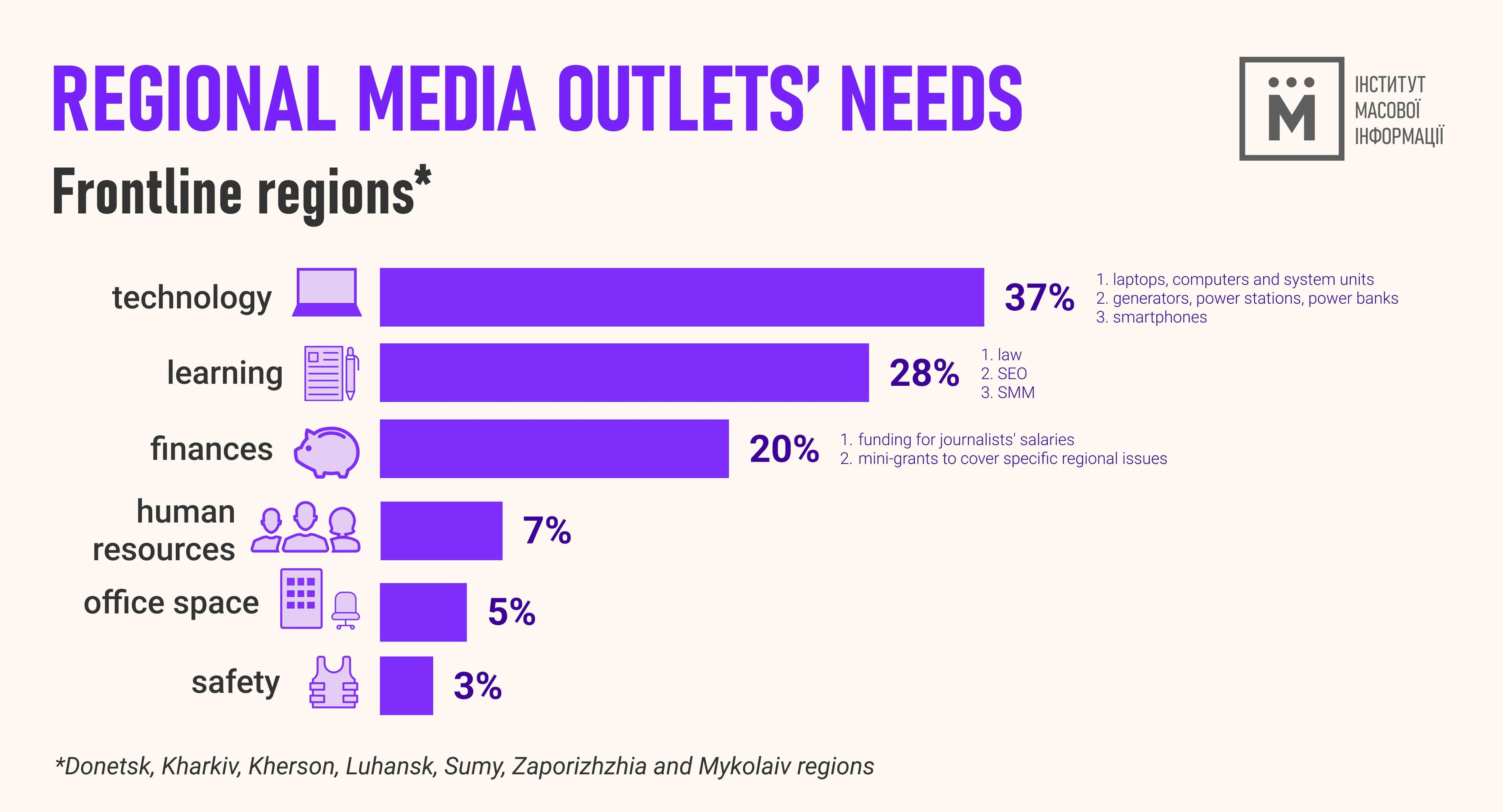
The needs of media outlets relocated from or based in the frontline oblasts
The media outlets we included in this category are the most vulnerable. These are the media which either work in the frontline regions under constant shelling or were forced to relocate and effectively rebuild their outlet from scratch. Seven oblasts were counted as the most endangered regions: Donetsk, Kharkiv, Kherson, Luhansk, Sumy, Zaporizhzhia, and Mykolaiv.
This category of media showed a need for technical equipment, reported by 37% of the surveyed outlets. The most urgent requests are for laptops, computers, and system units – these were reported by 18% of the media outlets. Most requests were coming from the Zaporizhzhia and Luhansk oblasts.
The demand for power generators, Ecoflow stations, and power banks is also high – 14% (it should be noted that the survey was carried out in February and the IMI estimates that this need has at least tripled since). Most requests for power equipment were coming from the Luhansk and Mykolaiv media. The highest demand for smartphones (9%) was reported by Sumy and Mykolaiv outlets.
The need for learning ranked second by urgency in the listed oblasts (28% of all requests). The top three capability building requests from the most vulnerable media category were related to:
- media law – 21%;
- SEO optimization – 11%;
- SMM – 10%.
This data shows that struggling media want not just to maintain their capabilities at the same level, but to develop their employees’ professional skills to adapt to the changing work conditions.
Underfunding remains a problem, seeing as one in every five requests (20%) from the frontline outlets reported it. Media workers need money to cover their journalists’ salaries (this problem is the most urgent in Kherson and Kharkiv); some also reported needing mini grants to report on the issues specific to the frontline regions.
At the same time the survey showed that the oblasts bordering on the frontline still struggle to attract human resources – 7% (of all needs). The lack of journalists and editors was mostly reported by Kharkiv and Kherson media.
Other needs of the frontline media outlets include safe office space (5%) and safety gear (3%), the latter remaining necessary as always.
The needs of media outlets in the frequently shelled regions
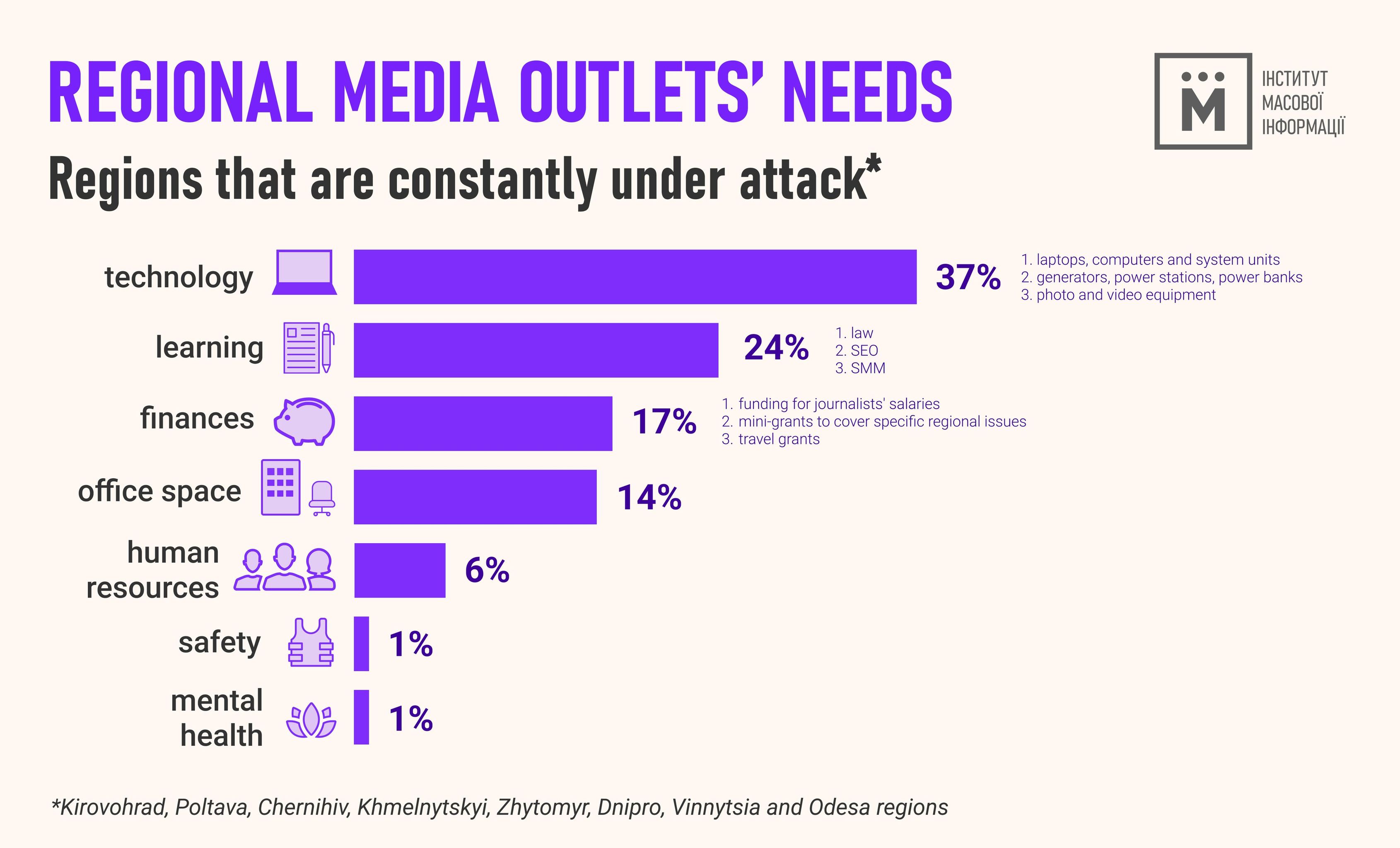
Needs of the outlets in the most frequently shelled oblasts
The needs of the media in the most frequently shelled regions are somewhat different from those of the frontline and relocated outlets. The survey covered the Kirovohrad, Poltava, Chernihiv, Khmelnytsky, Zhytomyr, Dnipropetrovsk, Vinnytsia, and Odesa oblasts. We stress that the list of the most shelled regions is not permanent and in reality the vast majority of Ukraine’s oblasts is under threat of shelling.
The analysis of Ukrainian media outlets’ requests showed a critical need in technical equipment, which ranked first among the identified needs – 37% of the total amount. This includes not just Ecoflow stations, laptops, and power banks, but also photo and video equipment, as well as hard drives and memory cards. The need for lighting equipment for filming and camera lenses was reported less often, but still present, which may point to an increasing demand for better visual journalism.
As for learning, 24% of the requests were about the media outlets’ desire to enhance their professional skills, with a demand for law education continuing to grow. The interest in SMM and SEO is also significant, which highlights the importance of digital presence and audience engagement for the media. At the same time, the mentions of grant application writing skills and strategy planning show the outlets’ willingness to develop more stable and strategy-focused approaches to management and funding. Some outlets have also reported a need to build their management skills to run their teams better.
Despite the Russian threat, journalists in the listed oblasts reported no wish to improve their knowledge of safety rules. There were sporadic requests for digital and security training, but no requests for first aid practice.
17% of the requests had to do with financial support, such as to cover the salaries and work trips expenses. This highlights the financial challenges faced by the media, especially those caused by the prolonged war threat.
14% of the media outlets need office space, and this need is much more urgent that it is, say, among the relocated or frontline outlets (5% of all the needs were related to renting or buying an office), which points to the difficulties the media are facing while searching for a stable and safe workspace.
There is also a need to attract additional human resources in the listed oblasts. The demand for personnel amounted to 6% of all needs. The reports were mostly coming from the Poltava, Khmelnytskyi, and Vinnytsia oblasts.
When it comes to safety gear, this demand only amounted to 1% of all needs, reported by Poltava journalists alone. Less than 1% of the requests had to do with mental health and rest. The journalists noted that they needed more days off and retreats and wanted a “diversion” from work. The low percentage of these demands may suggest that the media workers pay insufficient attention to safety and mental resilience, which can have long-term ramifications for journalism in the future.
What is the situation in other regions?
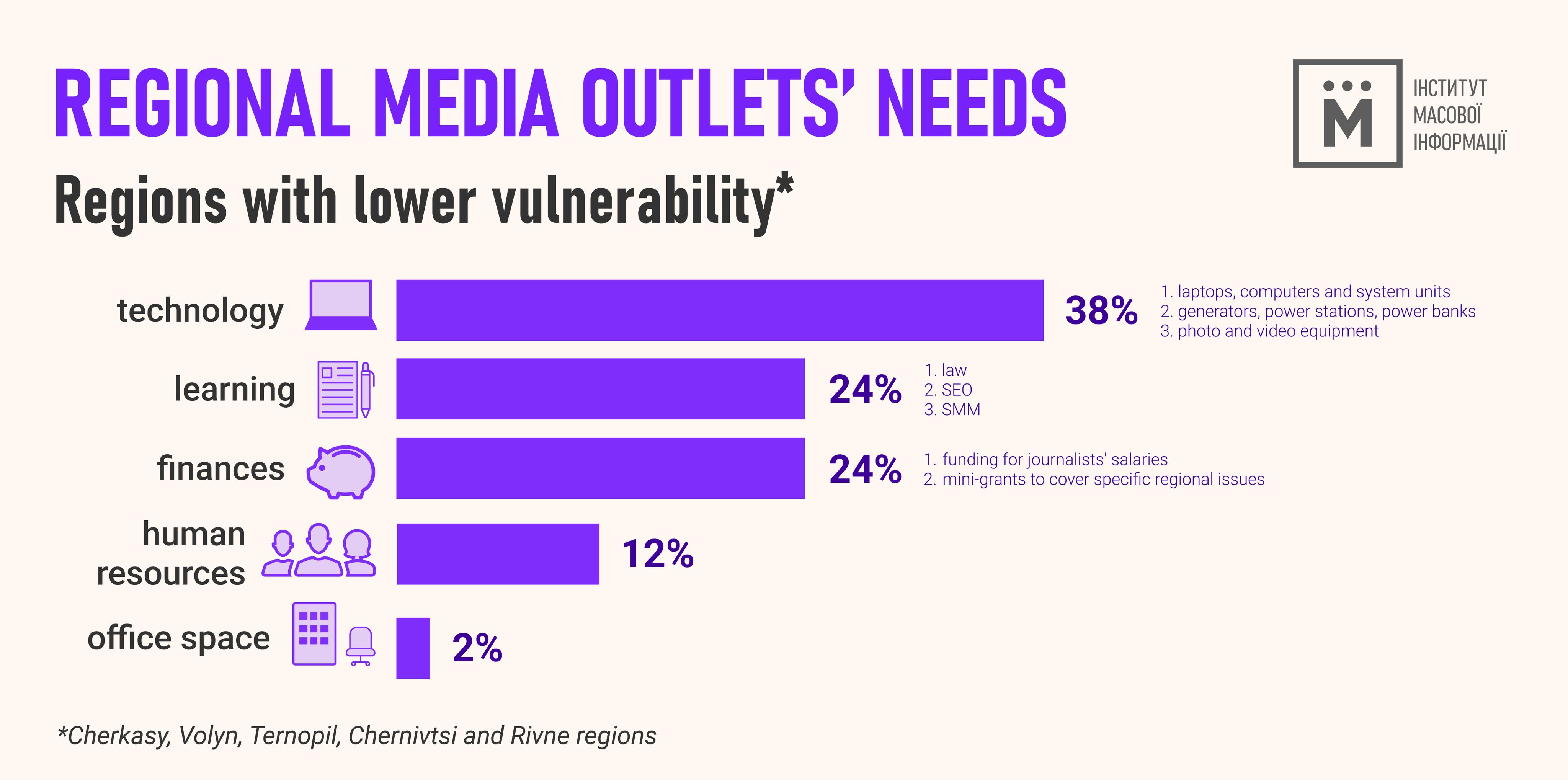
Surveying media outlets in Ukraine’s relatively “quiet” oblasts, such as Cherkasy, Ternopil, Rivne, Chernivtsi, and Volyn, showed that their primary need, too, is obtaining technical equipment to sustain their work. This suggests that supplying the media with technology remains critical for supporting high-quality journalism even in the less war-torn areas.
The demand for learning and financial support is also significant, amounting to 24% of all requests in each case. Requests for legal advice and high-quality media training highlight the media field’s need for constant evolvement. This matters not just to the novices, but to experienced journalists as well, which points to the growing complexity of the media landscape and the increasing skill requirements it entails. As for financial support, the listed demands reveal funding struggles, which affect salaries and the fulfillment of other financial obligations. This suggests that the war has made the development of stable business models considerably more difficult for the media working in times of economic uncertainty.
Notably, human resources amount to 12% of the outlets’ needs in the less endangered regions. The largest demand for qualified media workers was seen in Rivne, Lutsk, and Cherkasy, which highlights the necessity of attracting and training young journalists to bolster media teams.
The low demand for office space (merely 2%) and the absence of requests for safety training and mental health care suggest less attention to these aspects in the “quieter” regions as opposed to the frontline or more volatile areas. This may point to a relative stability in these oblasts, but also to the media potentially underrating the journalists’ safety and mental health needs. Such underestimation may add to their vulnerability in future crises.
THE IMI’S KEY FINDINGS AND RECOMMENDATIONS
- Supplying the media with technology: In view of the high demand for technological equipment, especially in the frontline regions, we recommend creating dedicated grant programs or funds to supply the media with necessary equipment. Such equipment may include Ecoflow stations, power banks, other types of power sources, as well as laptops, professional cameras, and microphones. The media outlets which lost their equipment to shelling or while working could use an opportunity to apply for a relevant mini grant.
- Capability building: We recommend creating and funding training programs focused on developing the media field and solving issues faced by journalists. These would include learning about professional standards, legal issues, SEO, SMM, using multimedia tools, etc. It is a good idea to cultivate workshops, webinars, and training classes which will help raise journalists’ skill level and enhance their competitiveness.
- Financial support: We recommend providing media outlets with consistent financial support, which would include helping these outlets pay off their employees’ salaries and cover operating expenses. We also recommend developing mechanisms to make emergency investments in media outlets facing unforeseen expenses due to the hostilities (e.g. forced to urgently relocate or lost their office space to a shelling strike).
- Promoting mental resilience: In view of the high stress levels among media workers (98%, as per the IMI's estimations), it is important to introduce mental health support programs, which should include counseling sessions with therapists and psychiatrists, paying off medication bills, group and individual therapy, organizing retreats and stress management classes. This will help reduce emotional burnout and build up journalists’ resilience.
- Bolstering human resources: We recommend investing in the attraction and training of new personnel in the media field. This may include fellowship programs for journalism students, internships, and mentorship programs; this will help attract young people and give them an opportunity to work in mass media while giving the media a chance to alleviate the staff shortage in times of war and crisis.
*The study was carried out through a quantitative online survey of a simple non-probability sample – chief editors of media outlets. A total of 254 outlets in 20 oblasts of Ukraine (Donetsk, Kirovohrad, Cherkasy, Poltava, Kharkiv, Chernihiv, Khmelnytskyi, Kherson, Luhansk, Volyn, Zhytomyr, Sumy, Ternopil, Chernivtsi, Zaporizhzhia, Mykolaiv, Dnipropetrovsk, Rivne, Vinnytsia, Odesa) were surveyed. The study was carried out throughout 2023.
Help us be even more cool!

